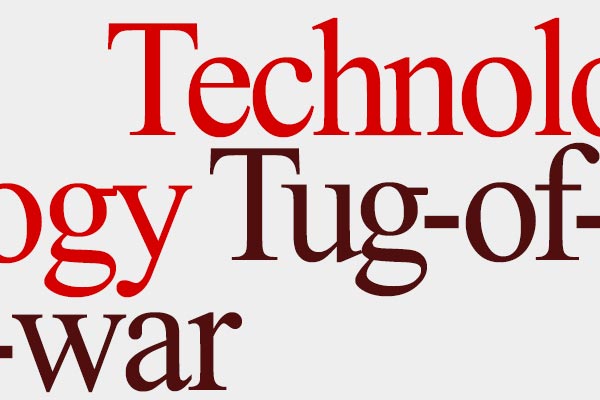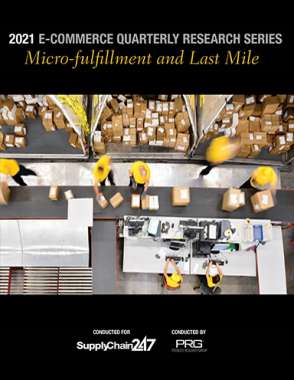2012 Materials Handling Technology Software Survey
In our annual software survey, Modern readers tell us that they’re are torn between embracing change and riding out older technologies.
For companies in manufacturing, warehousing, and distribution, the information about the movement of goods throughout the supply chain is as important as the actual movement of the goods—the tricky part is harnessing all that information to its fullest competitive advantage.
To gain a better understanding of how Modern readers are applying supply chain management (SCM) software to optimize their warehouse and distribution operations, Peerless Research Group (PRG) conducted Modern’s 2012 Software Usage Survey over the course of February 2012—and what we found about the usage of applications inside materials handling operations was pretty surprising.
Our readers told us they were engaged in a virtual tug-of-war between upgrading and riding out existing systems. Almost half of respondents (46%) were clustered in the middle of the bell curve in describing their companies as being cautious to embrace change when it comes to adopting new technology for its materials handling procedures.
At one end of the adoption curve, 9% described their companies as innovators and 14% identified themselves as early adopters. And on cautious side, 15% said they take a wait-and-see approach, while 14% admitted to being among the last to adopt technology.
These numbers are level with last year and send the message that most companies remain cautious about opening their wallets.
For example, Pitman Warehousing/Campbell’s Express, located in Pitman, N.J., has not implemented new software in more than three years. Warehouse manager Kevin Warner, who has been in the industry for 28 years, explains, “I follow the theory that if it’s not broken don’t fix it—unless you can show me the value of a change. Only then will we try to adopt it.”
We heard the same message when we asked if the current economic climate has changed companies’ approach to adopting supply chain software. And, 40% said that they are scrutinizing software investments and moving forward cautiously.
That’s the case at Sara Lee, according to Tony Weiland, operations engineer at the Chicago-based company. The current economic climate “has not had any effect on the company’s approach when it comes to adopting materials handling management software,” he says.
And, like the majority of respondents, Weiland says that they are evaluating software options—specifically solutions that reduce labor and costs and improve accuracy in picking and shipping processes. However, it’s likely that they will not be making any decisions for at least six months.
At one end of the purchasing spectrum, 20% said they definitely plan to hold off. LT Apparel Group, a family-owned operation based in New York, is one of those companies. “Right now we have no plans to spend money,” says Len Ladislaw, WMS administrator. “We have put off any purchase of software and are making modifications to our existing system to try to adapt.”
Of those companies planning to spend money on supply chain software in the next 12 months, 58% reported their investment will be less than $100,000; 32% plan to spend between $100,000 and $1 million; and 10% will spend more than $1 million.
The median spend in 2012 is reported to be $86,850, compared to $94,000 in 2011.
Although the spending level is slightly less this year, the numbers paint an overall picture of an industry that is holding steady. So, what did the study tell us about the major software categories?
Warehouse management systems
Warehouse management systems (WMS) control and optimize the movement of goods within a facility and related functions like receiving, storage, order fulfillment and shipping.
According to our survey, 67% of respondents, up from 60% in 2011, currently use a WMS and another 36% plan to evaluate, purchase or upgrade a WMS in the coming two years.
One key reason cited for buying a WMS is the pursuit of real time control over inventory, which went from 30% in 2011 up to 49% in 2012. Other reasons include the upgrade of an existing package (42%), better inventory deployment (36%), and better labor management (28%).
Warehouse control systems
According to the survey, about one in three (30%) companies use warehouse control system (WCS) software to manage real-time information and control the materials handling systems that move product from point A to point B. This figure is about level with last year (28%).
Of the 23% reporting plans to evaluate and possibly purchase a WCS system, 30% will take action within the next six months, while the remaining 70% expect to act on a WCS between six months and two years from now.
Of the companies planning to invest money in a WCS, 57% will purchase a new system and 43% will upgrade an existing system. And, for 35% it will be a stand-alone system, but for 65% it will be part of a larger automation initiative.
Readers also told us that existing users have had their WCS applications in place for an average of 6.8 years, upgraded it 2.7 years ago, and realized an ROI in 12.6 months.
Supply chain management and planning
Beyond the four walls of the warehouse, supply chain management and planning (SCMP) software integrates supply chain transactions between suppliers and customers while managing a number of business processes.
The 2012 survey indicated a growing need for SCMP in many areas:
- inventory visibility: 44% plan to buy or upgrade;
- procurement: 33% plan to buy or upgrade;
- order management: 37% plan to buy or upgrade;
- demand planning: 37% plan to buy or upgrade.
Those with SCMP in place have been using it on average of 6.3 years, upgraded it three years ago, and realized an ROI in 13.9 months.
Labor management
Labor management software (LMS), which optimizes workforce productivity, is currently used by 22% of responding companies, about level with 2011. LMS users have had the application in place for an average of 4.4 years, upgraded it 2.9 years ago, and realized the shortest average ROI at 9.9 months.
In addition, another 19% of respondents plan to evaluate or implement an LMS for their operation in about 11.5 months.
About 1 in 3, or 32%, are currently running engineered labor standards and 42% have an employee compensation program tied to productivity improvements. While nearly half have this type of incentive program in place, the other half, 58%, say they have no plans to go forward with an incentive program tied to productivity improvements.
Other software
Transportation management software (TMS) is on the move. Last year, 22% of respondents were using TMS to optimize the transport and delivery of goods. This year’s number is up to 30%, with another 18% saying they intend to make a move toward implementing TMS.
Asset tracking software, which tracks goods through the supply chain, is used by 20% of respondents compared to 26% last year. Another 18% of respondents will be evaluating asset tracking software applications in the coming months. On average, asset tracking applications have been in place 6.1 years and were upgraded 2.9 years ago. The average ROI is reported to be 12 months.
Slotting optimization software, which determines best storage location and rotation schedule for goods in a warehouse, is currently used by 14% of companies compared to 10% last year. The survey indicated that another 11% plan to evaluate slotting software in the coming months.
Forty-three percent of respondents said they re-slot their warehouse once a quarter, 13% re-slot twice a year, 35% once a year, and 9% re-slot less than once a year.
Yard management systems (YMS) control an operation’s inbound and outbound shipments in the yard and at the dock. Currently 9% of operations have a YMS in place, which is up from 7% in 2011. Another 7% plan to evaluate, purchase or upgrade their YMS in the next 24 months.
The remaining 9% of respondents tell us they do not currently use any of these software solutions. Further, 26% have no plans to evaluate, purchase or upgrade these software applications within the next 24 months.
Risk and reward
Regardless of the software application being considered, change is challenging and there is some risk involved with implementing supply chain software applications. Among the most significant risks, respondents told us, are compatibility issues, user acceptance, training, cost justifications, and the software living up to expectations.
ROI is another consideration. But according to this year’s survey, about half of the responding companies are not measuring ROI or don’t know yet if there has been a payback on the investment.
The risks of implementation, however, are balanced out by rewards. Respondents highlight a number of inventory management and process efficiencies that have been positively addressed through implementation of supply chain software solutions including: better control over storing and tracking inventory, increased volume, improved shipping accuracies and minimized downtime, to name a few.
One respondent said that during the last two years they had been looking to solve a variety of issues, “but the majority are associated with improving order picking, throughput and accuracy—and reducing costs.”
Cost at every junction is the name of the game. With spending flat, the message of the 2012 Software Usage Survey is that there is interest in software as a solution, but users are spending their money very carefully.
Respondent demographics
Modern’s 2012 Software Usage Study collected responses from 190 qualified individuals. To qualify, respondents must be personally involved in using, evaluating or purchasing software for their company’s materials handling operations.
This year’s respondents reflect management at all levels. Upper level management, meaning vice presidents, general managers and division managers, account for 41% while 46% are responsible for managing their company’s logistics distribution, warehouse, supply chain, traffic, operations or purchasing functions across both manufacturing and non-manufacturing vertical industries.
On the manufacturing side, which accounted for 54%, industrial machinery, automotive and transportation equipment, food and beverage, pharmaceuticals, computers and electronics, textiles and apparel, and aerospace were just a few of the verticals represented. On the non-manufacturing side, third party logistics providers, retail and wholesale trade, and transportation/warehousing services accounted for the remaining 46%.
While 15% of the companies report annual revenue of more than $1 billion, 33% are small businesses that report less than $10 million annually. The median revenue for 2012 is $42.8 million, down from $64 million in 2011, which tells us that this year’s group represents a slightly larger number of smaller companies.
Article Topics
Peerless Research Group News & Resources
2024 Intralogistics Robotics Survey: Robot demand surges 2024 Salary Survey: How Does Your Yearly Income Stack Up? 40th Annual Salary Survey: Salary and satisfaction up 2024 Warehouse/DC Outlook Survey: Cautious, but seeking efficiencies We love research The employee satisfaction survey: Don’t worry, be happy MRO Survey: Finding and keeping the best technicians More Peerless Research GroupLatest in Warehouse|DC
Talking Supply Chain: Understanding the FTC’s ban on noncompetes North Carolina Welcomes Amazon’s Newest Mega-Warehouse SAP Unveils New AI-Driven Supply Chain Innovations U.S. Manufacturing is Growing but Employment Not Keeping Pace Maximize Warehouse Space with Mezzanine Automation: Expert Tips Most Companies Unprepared For Supply Chain Emergency Microsoft Unveils New AI Innovations For Warehouses More Warehouse|DC













